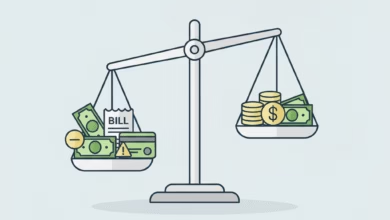Is it worth having a portfolio of only stocks?
What you should know before betting everything on equities

In the world of investing, the allure of an all-stock portfolio is undeniable. It represents the fast lane to wealth creation, championed by stories of incredible market runs and the undeniable long-term power of equities. For new investors, the idea of maximizing returns by going “all in” on the market’s biggest growth engine can be incredibly tempting. But is this high-octane strategy a golden ticket to financial freedom, or is it a high-stakes gamble that ignores the fundamental principles of risk management?
This article will provide a comprehensive and balanced analysis of the 100% equity portfolio. We will explore the powerful arguments in its favor, confront the serious and often underestimated risks involved, and provide a practical framework to help you decide if this aggressive approach aligns with your personal financial journey.
The Alluring Case for a 100% Equity Portfolio: Maximizing Growth Potential

The primary, and most compelling, reason to consider an all-stock portfolio is its unparalleled potential for long-term growth. History has shown that, over extended periods, no other mainstream asset class has been able to match the returns generated by the stock market.
1. The Undisputed Power of Historical Returns:
When you look at the data over decades, the story is remarkably consistent. Stocks, as measured by broad market indices like the S&P 500, have historically delivered average annual returns in the range of 9-10%. In contrast, less volatile assets like government bonds have typically returned closer to 4-5%. While past performance is not a guarantee of future results, this long-term historical data forms the foundation of the argument for a stocks-only approach. Over a multi-decade investing career, that difference in compound returns is staggering. A few percentage points each year can translate into hundreds of thousands, or even millions, of additional dollars by retirement.
2. Your Greatest Ally: A Long Time Horizon:
The effectiveness of an all-stock strategy is directly tied to an investor’s time horizon. For a young investor in their 20s or early 30s, retirement is 30-40 years away. This extended timeframe is a massive advantage because it provides ample time to recover from the inevitable market downturns. A 40% drop in the market, while painful in the short term, becomes a mere blip on the radar when viewed over a 40-year chart. The young investor not only has time to wait for a recovery but can also continue to invest during the downturn, buying shares at a “discount.”
3. Unleashing the Full Force of Compounding:
Compounding is the magic of earning returns on your returns. The higher the rate of return, the more powerful the compounding effect becomes. By allocating 100% of your portfolio to the highest-growth asset class, you are creating the most fertile ground for compounding to work its magic. The goal of this strategy is to maximize the growth of your “snowball” in the early years, creating a much larger base upon which future, more conservative returns can be built later in life.
Why a ‘Stocks-Only’ Strategy Isn’t a Free Lunch: Understanding the Brutal Risks
While the potential rewards are high, the risks associated with a 100% equity portfolio are equally immense and must be understood and respected. Ignoring these risks is one of the most common and damaging mistakes an investor can make.
1. The Reality of Volatility and Devastating Drawdowns:
An all-stock portfolio exposes you to the full, unfiltered volatility of the stock market. While we talk about average annual returns of 10%, that journey is never a straight line. It is a series of sharp climbs and stomach-churning drops. Major market crashes, or “drawdowns,” are a regular feature of the investment landscape:
- The Dot-Com Bust (2000-2002): The S&P 500 fell by approximately 49%.
- The Global Financial Crisis (2007-2009): The S&P 500 plummeted by roughly 57%.
- The COVID-19 Crash (Feb-Mar 2020): The S&P 500 dropped 34% in a matter of weeks.
It’s crucial to grasp the mathematics of recovery. If your portfolio falls by 50%, you don’t need a 50% gain to get back to even; you need a 100% gain. Experiencing such a loss can be financially and psychologically crippling.
2. The Psychological Toll: Your Brain is Your Biggest Enemy:
Reading about a 50% drawdown is academic. Living through one is a visceral, terrifying experience. Every financial news headline screams crisis, and your life savings appear to be evaporating. The emotional pressure to “just sell and make it stop” becomes immense. The single biggest danger of an all-stock portfolio is that its volatility may cause you to abandon your investment plan at the worst possible moment—selling at the bottom and locking in devastating losses. A slightly lower-return portfolio that you can stick with is infinitely better than a high-return portfolio that you abandon in a panic.
3. Sequence of Returns Risk: The Retirement Killer:
This is a more advanced but absolutely critical concept. Sequence of returns risk is the danger that the timing of your investment returns is unfavorable. If you suffer a major market crash right after you retire and begin withdrawing money, the impact can be catastrophic. Selling assets in a down market to fund your living expenses permanently depletes your portfolio’s ability to recover. This is why a 100% stock portfolio is almost universally considered reckless for those in or near retirement.
The Unsung Hero: What is the Role of Bonds in a Modern Portfolio?

To counteract the intense risks of an all-stock portfolio, investors turn to other asset classes, chief among them being bonds. Often misunderstood as “boring” or only for retirees, bonds play several crucial roles that can dramatically improve a portfolio’s resilience.
1. The Shock Absorber: Dampening Volatility:
The primary role of high-quality government and corporate bonds is to act as a stabilizing force. Bonds typically have a low or negative correlation to stocks. This means that during periods of economic fear and stock market panic, investors often flock to the perceived safety of bonds, causing their prices to rise. This “zag” when stocks “zig” acts like a shock absorber for your portfolio, cushioning the overall blow during a downturn and reducing the severity of your losses.
2. The Dry Powder: A Source for Rebalancing:
A portfolio that includes bonds provides “dry powder”—a source of stable capital that can be used to buy stocks when they are cheap. During a market crash, a disciplined investor can sell some of their bonds (which have likely held their value or even appreciated) and use the proceeds to buy stocks at bargain prices. This rebalancing act forces you to systematically buy low and sell high, and it’s only possible if you have a non-stock asset to sell from.
3. The Income Generator: Providing Predictable Cash Flow:
Bonds pay out regular interest (coupon payments), providing a steady and predictable stream of income. For retirees, this income is vital for covering living expenses. For younger investors, this income can be reinvested, further fueling the portfolio’s growth.
How Your Age and Time Horizon Dictate Your Portfolio Strategy
The appropriateness of an aggressive, all-stock allocation is almost entirely dependent on your age and stage in your investment journey.
The Young Investor (20s-30s):
This is the only demographic that could plausibly consider a 100% equity strategy. With 30+ years until retirement, they have the maximum time horizon to recover from any market crash. However, even for this group, the psychological risk remains the biggest hurdle. A more prudent approach for most young investors might be a 90% stock / 10% bond portfolio. That small allocation to bonds provides a slight cushion, a tool for rebalancing, and an early lesson in the benefits of diversification without significantly sacrificing long-term returns.
The Mid-Career Investor (40s-50s):
At this stage, your focus begins to subtly shift from pure accumulation to a mix of growth and capital preservation. You have less time to recover from a major loss, and the “sequence of returns risk” starts to appear on the horizon. An all-stock portfolio becomes increasingly inappropriate. Allocations like 70/30 or 80/20 (stocks/bonds) become far more common and sensible, offering a balance between continued growth and meaningful risk reduction.
The Pre-Retiree and Retiree (60s+):
For this group, an all-stock portfolio is a recipe for disaster. Capital preservation is paramount. A major market downturn at this stage could permanently alter one’s standard of living in retirement. A balanced or conservative allocation, such as 60/40 or even 40/60 (stocks/bonds), is essential to protect the nest egg that has taken a lifetime to build.
Finding the Right Balance for Your Journey

So, is an all-stock portfolio worth it? For a very small subset of young, iron-willed investors with a multi-decade time horizon and a stable financial life, it could be a viable, albeit highly aggressive, path.
However, for the vast majority of investors, the answer is a resounding no. The brutal psychological toll of unfiltered market volatility and the very real danger of catastrophic loss at an inopportune time make the strategy untenable. The quest for slightly higher returns is often not worth the sleepless nights and the risk of derailing your entire financial plan.
Ultimately, the most successful investment strategy is the one you can stick with, through good times and bad. For most people, that means building a diversified portfolio that includes a meaningful allocation to bonds and other non-stock assets. This balanced approach provides a smoother ride, better risk-adjusted returns, and, most importantly, the peace of mind to stay invested for the long haul—which is the true secret to building lasting wealth.





